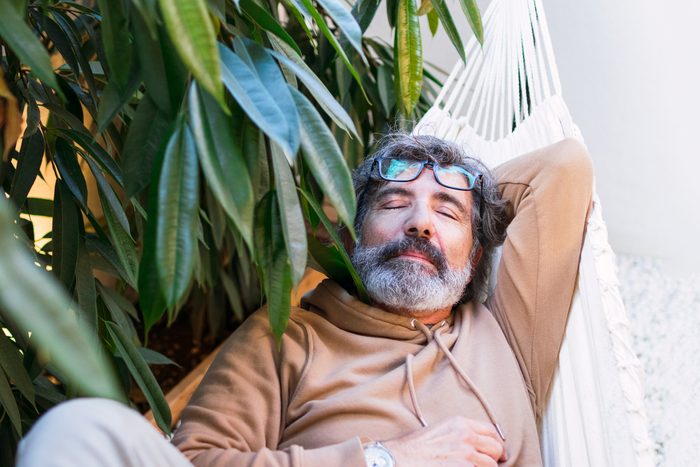Napping for This Long Could Reduce Your Diabetes Risk, Says Research
Updated: Sep. 18, 2023

There could be a sneaky little link between your blood sugar and a daytime snooze. Here's how to know when you should catch a rest during the day.
The pandemic might have shifted how you care for yourself, including during typical work-a-day demands…and maybe you’ve discovered that slightly looser professional parameters have granted you with a little flexibility for a short afternoon nap. Some experts suggest that if you follow a few guidelines, a small nap could actually be a way to prevent chronic disease—namely, type 2 diabetes.
To start, Kevin Peterson, MD, MPH, says your blood sugar is largely influenced by two main factors:
- How long it’s been since you last ate—and if it’s been hours, that’s known as your “resting blood sugar” level;
- and what you eat.
Dr. Peterson is the vice president of primary care for the American Diabetes Association and a professor at University of Minnesota Medical School. He points to recent research that suggests a noteworthy link between sleep and insulin sensitivity. The stronger your insulin sensitivity, the better your body is poised to fend off diabetes.
Keep reading for more on the connection between naps and diabetes risk.
Possible effects of sleep on diabetes risk
“Usually blood sugar will go down during the night until it reaches a resting level,” Dr. Peterson says. “Then it stays the same the rest of the night.”
As for naps? “What happens with blood sugar when you take a nap depends mostly on when and what you last ate,” he explains.
As a general thought process, that makes sense—but there’s some nuance. Here’s how research suggests the naps and diabetes connection plays out, according to Stacey L. Simon, PhD, an associate professor with a concentration in sleep science at University of Colorado Anschutz Medical Campus: In some cases, regular daytime napping has been associated with an increased risk for developing type 2 diabetes, and patients with type 2 diabetes who regularly napped had higher HbA1c. HbA1c, short for “hemoglobin A1c,” is a marker of blood glucose control. In diabetics, a prolonged elevated HbA1c level can increase the risk of developing further serious complications.
Other research, such as a 2016 study in the peer-reviewed journal Nature, showed that regularly sleeping for longer than 60 minutes was linked to a higher type 2 diabetes risk compared to no nap. Another 2016 study found that longer naps—meaning those lasting longer than 40 minutes—were linked to increased risk for metabolic disease.
Shorter naps weren’t linked to diabetes, that same study found.
Other 2016 research showed for diabetes patients whose nighttime sleep was cut short, a nap improved glycemic (blood sugar) levels.
Here’s Why You’re Hungry After a Nap, Says a Nutrition Expert
If you’re not able to get enough sleep at night, a nap could help, Catherine Lowry, a graduate research assistant in Colorado State University’s Sleep and Metabolism Clinical Research Laboratory—maybe just not every day. A 2017 meta-analysis of seven studies on more than 249,000 people found people who took habitual daytime naps had a 17% higher chance of developing diabetes compared to those who didn’t nap during the day. A 2023 study involving more than 53,000 participants found regular daytime napping is linked with a risk for diabetes in most adults, except for premenopausal females.
This could be because long naps interfere with sound nighttime sleep, which can negatively impact the body’s processing of sugar. The longer naps and diabetes correlation could also be connected with an overall more sedentary lifestyle and increased chance of obesity.
Study: Walking Daily Can Reduce Your Diabetes Risk by 74%
Is napping good for diabetes?
If you do have diabetes, Simon says that a brief nap under 40 minutes may be helpful. “However, people should be aware that daytime napping can negatively impact nighttime sleep such that they may not feel as sleepy at their regular bedtime and it may take longer to fall asleep or result in a poor night of sleep,” she says. “If people are going to nap in the day, they should aim for early and brief—early enough and short duration so it doesn’t inadvertently lead to a poor night of sleep.”
Another bright rule of thumb might be to make sure you move your body for a period sometime in the day before you take a short nap…this could make that rest feel even more satisfying.
A Diabetes Specialist Just Shared the ‘Biggest Mistake’ That Increases Diabetes Risk
Should I take a nap if I don’t have diabetes?
If you’re already getting seven to nine hours a night, regular exercise can help lower how much time it takes to get to sleep and improve the quality of your sleep, Lowry adds.
Dr. Peterson says maintaining a healthy lifestyle is key. A nap can be a welcome and restful part of a balanced self-management program for a person with or without diabetes, he says. “Very high or very low blood sugars can both make a person fatigued, but that type of fatigue isn’t usually what makes a person decide to take a nap,” Dr. Peterson notes. “Stress can cause blood sugars to go up, and taking a nap can be a good stress reliever.”















